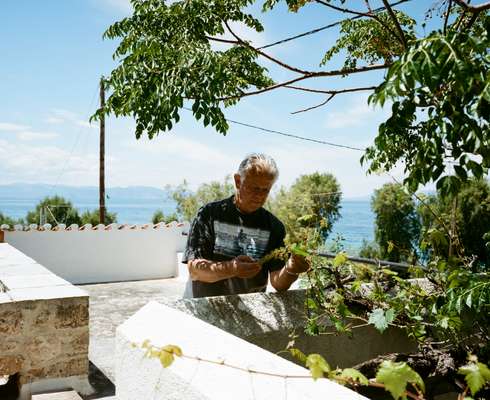July/ August 2014 / Greece
Expo 75: Aegina
Cascais, Hayama, Aegina, Sai Kung and Outer Sunset: five commuter towns with distinct personalities.
Why live in Aegina? Most locals are dumbfounded by the question, mainly because the answer surrounds you: the sea. Life on a Greek island only 40 minutes away from the busy capital of Athens has clear advantages.
Every day at around 07.00 George Kalamakis, a father of three, walks to the island’s port where he hops on a Flying Dolphin high-speed passenger boat to start his commute to work at a bank on the mainland. But it’s the trip back that he relishes. “As soon as you board the boat home it feels like you are travelling to another planet; that whiff of sea water just transforms the air, leaving all that city pollution and car noise behind,” he says.
Aegina, 27km south of Athens, is one of the islands of the Saronic Gulf, an area regarded as a watery suburb of Athens. The plethora of beaches and azure sea surrounding Aegina are an obvious perk to life on an island but Aeginians are rather blasé about it all: they’ll only venture out for a dip in its shallow waters when temperatures hit close to 30c. But locals say that there’s more to Aegina than its relaxed summer culture anyway. “Life is simply much nicer here; I wouldn’t sacrifice it for anything,” says Kalamakis. Like many of the island’s 13,000 residents, he says he enjoys “the sense of community, speaking to everyone, looking after my trees and my garden and watching the sunset while I drink my tsipouro [Greek brandy] on the harbour”.





The main port of Aegina sits at the tip of a small bay, lined with yellow, white and pink 19th-century neo-classical buildings with the odd church bell protruding from behind. In the twisting and narrow backstreets, cats snooze on the colourful sunlit windowsills and the only thing that disturbs the tranquility is the noise of a moped zooming past. These noisy motorcycles, the preferred mode of transport for everyone from elderly ladies dressed in black to families of three, are another hallmark of the lifestyle here. Even dogs hitch rides with their owners, sitting tightly on their laps, while helmets seem to be reserved for tourists.
As with any self-respecting Greek region, Aegina has left its mark on history. It was one of the first places in the world to mint its own coins. But its contribution to art is what locals are most proud of. The beautifully preserved temple of Aphaia, which sits above a pine forest, was dedicated to the goddess Aphaia (who was worshiped solely on the island) in the 5th century BC. The Doric-styled temple is said to have inspired the architects of Athens’ Parthenon, Greece’s most celebrated structure.
The island has also captivated and inspired numerous artists over the years: the writer Nikos Kazantzakis, sculptor Christos Kapralos and painters Nikos Nikolaou and Yannis Moralis have produced a wealth of important works. Islanders boast that Kazantzakis wrote his classic novel Zorba the Greek on Aegina during the 1940s. Many put the island’s allure for artists down to the light. “There is a very particular light; when the sun comes out the light is blinding and the shadows and contrasts are strong,” says sculptor Nektarios Kontovrakis.
On the seafront, Aiakeion – an old pastry and coffee shop that specialises in pistachio desserts – is the hangout for resident artists. Moralis used to refer to the café as his office, where he would arrange meetings with friends, journalists and colleagues. Dimitra Koukouli opened Aiakeion in 1958 and she continues to visit her store most days, although it’s now run by her children.
Cafés, ouzeri and tavernas have all but taken over the seafront where caïques – traditional fishing vessel used across the Aegean sea – are moored. Around midday, when the fishermen have returned with their catch, the chatting and clinking of ouzo-filled glasses can be heard along the seafront as the men take an early lunch of cheese, slices of fresh tomato and cucumber.
Although the country’s woes can seem far away to the casual onlooker, even here the conversation revolves around the political and financial crisis that has been pummeling Greece since 2008. The sparsely filled stalls at the fish market are evidence that the islands, and Aegina, are not immune to the country’s troubles.
In addition to the fish and tourism, Aegeans live off an unlikely nut: the pistachio. Groves of these evergreen trees have spread across the island, planted in gardens, backyards and farms. The particular soil and climate of the island endow the pistachios with such a unique flavour that they’ve been registered as an EU product with a protected designation of origin. According to estimates, Greece is the sixth-highest producer of pistachios in the world. A pistachio frenzy has seized the island, producing everything from pistachio-based spreads to spirits.
Among the locals are the so-called “Fridayers”, or paraskevaides. The term is used to describe residents who spend their week in the raucous capital but return to the island every Friday. Due to this proximity to the capital, an increasing number of other Europeans have also been moving to Aegina. But despite a new sophistication that pervades parts of the island and its small bars, life remain low profile for the Athens commuter set that has ditched the city for the sea.


